Paper Menu >>
Journal Menu >>
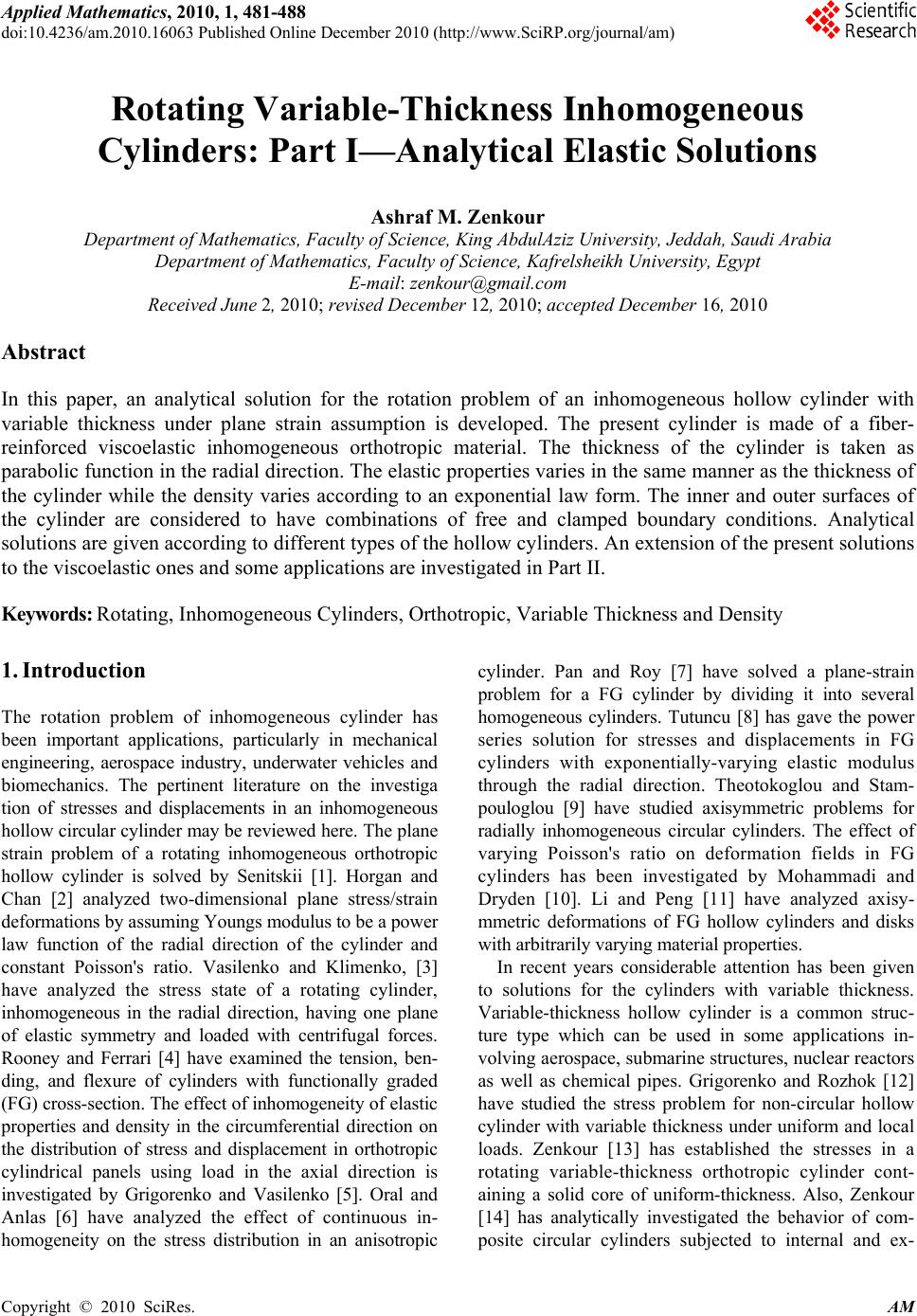 Applied Mathematics, 2010, 1, 481-488 doi:10.4236/am.2010.16063 Published Online December 2010 (http://www.SciRP.org/journal/am) Copyright © 2010 SciRes. AM Rotating Variable-Thickness Inhomogeneous Cylinders: Part I—Analytical Elastic Solutions Ashraf M. Zenkour Department of Mathematics, Faculty of Science, King AbdulAziz University, Jeddah, Saudi Arabia Department of Mathematics, Faculty of Science, Kafrelsheikh University, Egypt E-mail: zenkour@gmail.com Received June 2, 2010; revised December 12, 2010; accepted December 16, 2010 Abstract In this paper, an analytical solution for the rotation problem of an inhomogeneous hollow cylinder with variable thickness under plane strain assumption is developed. The present cylinder is made of a fiber- reinforced viscoelastic inhomogeneous orthotropic material. The thickness of the cylinder is taken as parabolic function in the radial direction. The elastic properties varies in the same manner as the thickness of the cylinder while the density varies according to an exponential law form. The inner and outer surfaces of the cylinder are considered to have combinations of free and clamped boundary conditions. Analytical solutions are given according to different types of the hollow cylinders. An extension of the present solutions to the viscoelastic ones and some applications are investigated in Part II. Keywords: Rotating, Inhomogeneous Cylinders, Orthotropic, Variable Thickness and Density 1. Introduction The rotation problem of inhomogeneous cylinder has been important applications, particularly in mechanical engineering, aerospace industry, underwater vehicles and biomechanics. The pertinent literature on the investiga tion of stresses and displacements in an inhomogeneous hollow circular cylinder may be reviewed here. The plane strain problem of a rotating inhomogeneous orthotropic hollow cylinder is solved by Senitskii [1]. Horgan and Chan [2] analyzed two-dimensional plane stress/strain deformations by assuming Youngs modulus to be a power law function of the radial direction of the cylinder and constant Poisson's ratio. Vasilenko and Klimenko, [3] have analyzed the stress state of a rotating cylinder, inhomogeneous in the radial direction, having one plane of elastic symmetry and loaded with centrifugal forces. Rooney and Ferrari [4] have examined the tension, ben- ding, and flexure of cylinders with functionally graded (FG) cross-section. The effect of inhomogeneity of elastic properties and density in the circumferential direction on the distribution of stress and displacement in orthotropic cylindrical panels using load in the axial direction is investigated by Grigorenko and Vasilenko [5]. Oral and Anlas [6] have analyzed the effect of continuous in- homogeneity on the stress distribution in an anisotropic cylinder. Pan and Roy [7] have solved a plane-strain problem for a FG cylinder by dividing it into several homogeneous cylinders. Tutuncu [8] has gave the power series solution for stresses and displacements in FG cylinders with exponentially-varying elastic modulus through the radial direction. Theotokoglou and Stam- pouloglou [9] have studied axisymmetric problems for radially inhomogeneous circular cylinders. The effect of varying Poisson's ratio on deformation fields in FG cylinders has been investigated by Mohammadi and Dryden [10]. Li and Peng [11] have analyzed axisy- mmetric deformations of FG hollow cylinders and disks with arbitrarily varying material properties. In recent years considerable attention has been given to solutions for the cylinders with variable thickness. Variable-thickness hollow cylinder is a common struc- ture type which can be used in some applications in- volving aerospace, submarine structures, nuclear reactors as well as chemical pipes. Grigorenko and Rozhok [12] have studied the stress problem for non-circular hollow cylinder with variable thickness under uniform and local loads. Zenkour [13] has established the stresses in a rotating variable-thickness orthotropic cylinder cont- aining a solid core of uniform-thickness. Also, Zenkour [14] has analytically investigated the behavior of com- posite circular cylinders subjected to internal and ex- 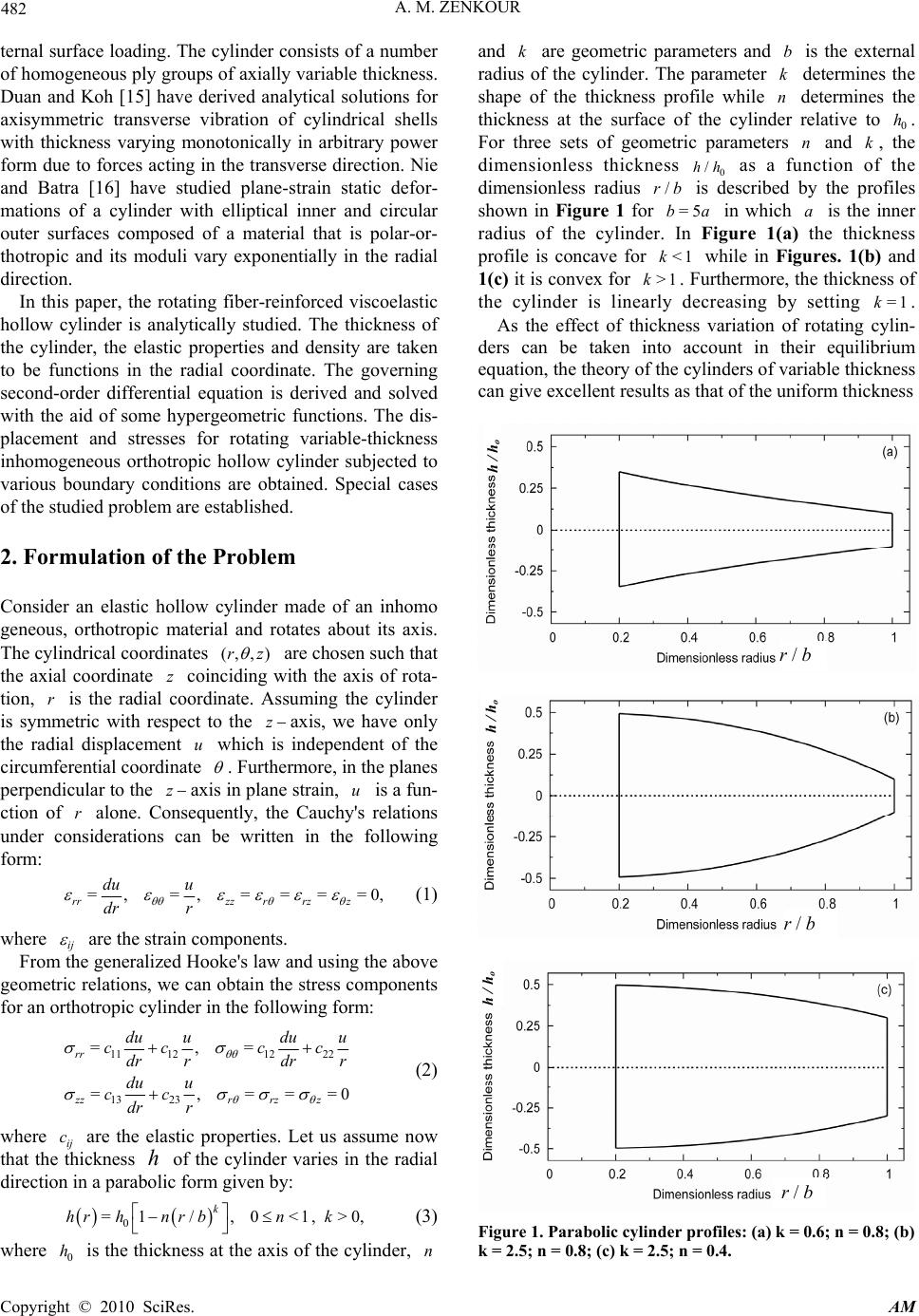 A. M. ZENKOUR Copyright © 2010 SciRes. AM 482 ternal surface loading. The cylinder consists of a number of homogeneous ply groups of axially variable thickness. Duan and Koh [15] have derived analytical solutions for axisymmetric transverse vibration of cylindrical shells with thickness varying monotonically in arbitrary power form due to forces acting in the transverse direction. Nie and Batra [16] have studied plane-strain static defor- mations of a cylinder with elliptical inner and circular outer surfaces composed of a material that is polar-or- thotropic and its moduli vary exponentially in the radial direction. In this paper, the rotating fiber-reinforced viscoelastic hollow cylinder is analytically studied. The thickness of the cylinder, the elastic properties and density are taken to be functions in the radial coordinate. The governing second-order differential equation is derived and solved with the aid of some hypergeometric functions. The dis- placement and stresses for rotating variable-thickness inhomogeneous orthotropic hollow cylinder subjected to various boundary conditions are obtained. Special cases of the studied problem are established. 2. Formulation of the Problem Consider an elastic hollow cylinder made of an inhomo geneous, orthotropic material and rotates about its axis. The cylindrical coordinates (, ,)rz are chosen su ch th a t the axial coordinate z coinciding with the axis of rota- tion, r is the radial coordinate. Assuming the cylinder is symmetric with respect to the zaxis, we have only the radial displacement u which is independent of the circumferential coordinate . Furthermore, in the planes perpendicular to the zaxis in plane strain, u is a fun- ction of r alone. Consequently, the Cauchy's relations under considerations can be written in the following form: =,=,= == =0, rrzz rrzz du u dr r (1) where ij are the strain components. From the generalized Hooke's law and using the above geometric relations, we can obtain the stress components for an orthotropic cylinder in the following form: 11 121222 13 23 =,= =,===0 rr zzr rz z du uduu cc cc dr rdrr du u cc dr r (2) where ij c are the elastic properties. Let us assume now that the thickness h of the cylinder varies in the radial direction in a parabolic form given by: 0 =1/,0 <1,>0, k hrhnr bnk (3) where 0 h is the thick ness at the axis of the cylinder, n and k are geometric parameters and b is the external radius of the cylinder. The parameter k determines the shape of the thickness profile while n determines the thickness at the surface of the cylinder relative to 0 h. For three sets of geometric parameters n and k, the dimensionless thickness 0 /hh as a function of the dimensionless radius /rb is described by the profiles shown in Figure 1 for =5ba in which a is the inner radius of the cylinder. In Figure 1(a) the thickness profile is concave for <1k while in Figures. 1(b) and 1(c) it is conv ex for >1k. Furthermore, the thickness of the cylinder is linearly decreasing by setting =1k. As the effect of thickness variation of rotating cylin- ders can be taken into account in their equilibrium equation, the theory of the cylin d ers of variable th ickness can give excellent results as that of the uniform thickness Figure 1. Parabolic cylinder profiles: (a) k = 0.6; n = 0.8; (b) k = 2.5; n = 0.8; (c) k = 2.5; n = 0.4. h / ho h / ho h / ho r / b r / b r / b 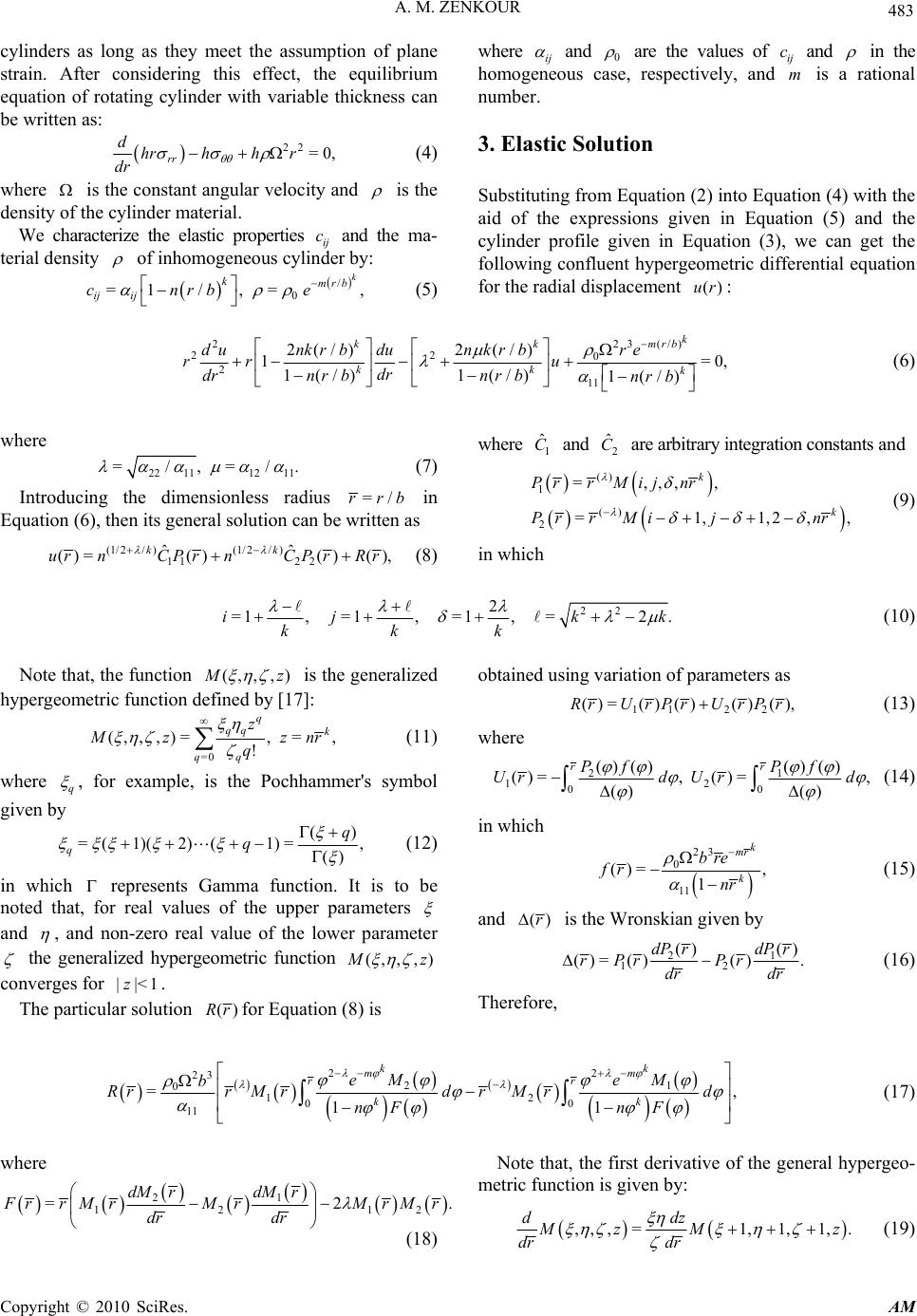 A. M. ZENKOUR Copyright © 2010 SciRes. AM 483 cylinders as long as they meet the assumption of plane strain. After considering this effect, the equilibrium equation of rotating cylinder with variable thickness can be written as: 22 =0, rr dhrhh r dr (4) where is the constant angular velocity and is the density of the cylinder material. We characterize the elastic properties ij c and the ma- terial density of inhomogeneous cylinder by: / 0 =1/ ,=, k kmrb ij ij cnrb e (5) where ij and 0 are the values of ij c and in the homogeneous case, respectively, and m is a rational number. 3. Elastic Solution Substituting from Equation (2) into Equation (4) with the aid of the expressions given in Equation (5) and the cylinder profile given in Equation (3), we can get the following confluent hypergeometric differential equation for the radial displacement ()ur : 23 (/)2 22 0 211 2 (/)2(/) 1=0, 1(/)1(/) 1(/) k mr bkk kk k red unk rbdunk rb rr u dr drn rbn rbnr b (6) where 22 1112 11 =/,=/. (7) Introducing the dimensionless radius =/rrb in Equation (6), then its general solution can be written as (1/2/ )(1/2/ ) 112 2 ˆˆ ()=()() (), kk urnCPrnCP rRr (8) where 1 ˆ C and 2 ˆ C are arbitrary integration constants and () 1 () 2 =,,,, =1,1,2,, k k Prr Mijnr Pr r Mijnr (9) in which 22 2 =1,=1,=1,=2 . ij kk kkk (10) Note that, the function (,, ,) M z is the generalized hypergeometric function defined by [17]: =0 (,, ,)=,=, ! q qq k q q z M zznr q (11) where q , for example, is the Pochhammer's symbol given by () =(1)(2)(1)=, () qq q (12) in which represents Gamma function. It is to be noted that, for real values of the upper parameters and , and non-zero real value of the lower parameter the generalized hypergeometric function (,, ,) M z converges for ||<1z. The particular solution () R rfor Equation (8) is obtaine d u sing vari ation of parame t e r s as 112 2 ()=() ()()(), R rU rPrUrPr (13) where 21 12 00 ()() ()() ()=, ()=, () () rr Pf Pf UrdUrd (14) in which 23 0 11 ()= , 1 k mr k bre fr nr (15) and ()r is the Wronskian given by 21 12 () () ()= ()(). dPrdP r rPrPr dr dr (16) Therefore, 22 23 21 012 00 11 = , 11 kk mm rr kk eM eM b RrrM rdrMrd nF nF (17) where 21 12 12 =2. dMrdM r FrrM rMrMrMr dr dr (18) Note that, the first derivative of the general hypergeo- metric function is given by: , ,,=1,1,1,. ddz M zM z dr dr (19) 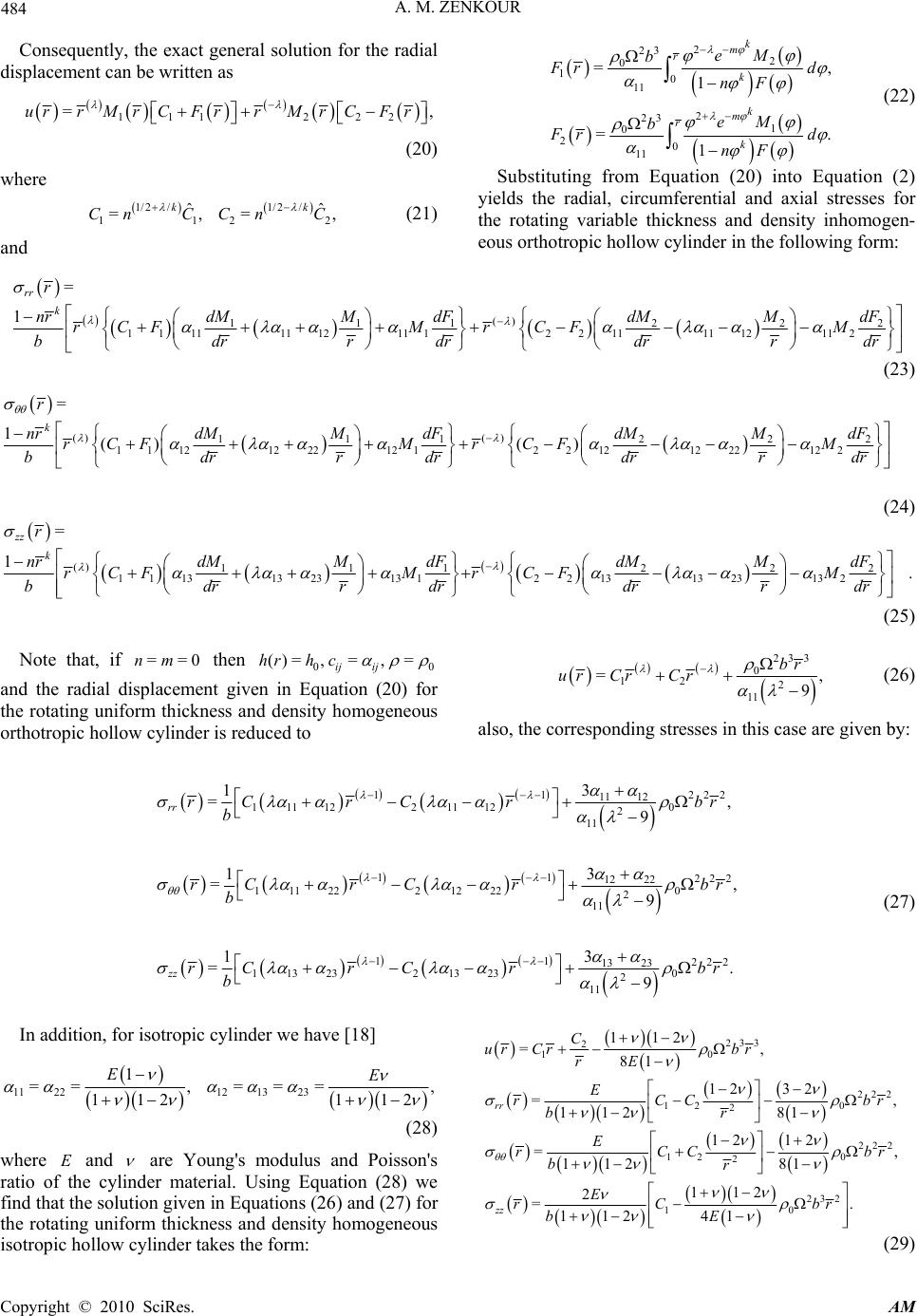 A. M. ZENKOUR Copyright © 2010 SciRes. AM 484 Consequently, the exact general solution for the radial displacement can be written as 1112 22 =,urrMrCF rrMrCFr (20) where 1/2 /1/2 / 112 2 ˆˆ =,=, kk Cn CCn C (21) and 2 23 2 0 10 11 2 23 1 0 20 11 =, 1 =. 1 k m r k k m r k eM b Fr d nF eM b Fr d nF (22) Substituting from Equation (20) into Equation (2) yields the radial, circumferential and axial stresses for the rotating variable thickness and density inhomogen- eous orthotropic hollow cylinder in the following form: () 111 222 1111111211 122111112112 = 1 rr k r nrdMM dFdMMdF rCFMr CFM bdrr drdrrdr (23) () () 111222 1112122212122121222122 = 1()( ) k r nrdMM dFdMMdF rCFMr CFM bdrrdrdrrdr (24) () 111222 1113132313 122131323132 = 1. zz k r nrdMM dFdMMdF rCFMr CFM bdrrdrdrrdr (25) Note that, if ==0nm then 00 ()= ,=, = ij ij hrhc and the radial displacement given in Equation (20) for the rotating uniform thickness and density homogeneous orthotropic hollow cylinder is reduced to 233 0 12 2 11 =, 9 br ur CrCr (26) also, the corresponding stresses in this case are given by: 11 222 11 12 111 12211 120 2 11 11 222 12 22 111 22212220 2 11 11 222 13 23 113 23213 230 2 11 13 =, 9 13 =, 9 31 =. 9 rr zz rC rCrbr b rC rCrbr b rC rCrbr b (27) In addition, for isotropic cylinder we have [18] 11 2212 1323 1 == ,=== , 112 112 EE (28) where E and are Young's modulus and Poisson's ratio of the cylinder material. Using Equation (28) we find that the solution given in Equations (26) and (27) for the rotating uniform thickness and density homogeneous isotropic hollow cylinder takes the form: 233 2 10 222 12 0 2 222 12 0 2 232 10 112 =, 81 12 32 =, 112 81 12 12 =, 112 81 112 2 =. 112 41 rr zz C ur Crbr rE E rCC br br E rCC br br E rC br bE (29)  A. M. ZENKOUR Copyright © 2010 SciRes. AM 485 The previous elastic solutions will be completed by calculating the integration constantsi Cusing various bo- undary conditions on the surfaces of the hollow cylinder. 4. Rotation of Elastic Hollow Cylinders In the present section, we will obtain the elastic so lutions for the rotating hollow cylinder. For the present hollow cylinder, the solution requires that one boundary con- dition be satisfied at each surface. The radial stress must be vanished at the free surface (F) of the cylinder while the radial displacement must be equal to zero at the clamped surface (C) of the cylinder. 4.1. Free-Free (FF) Hollow Cylinder When the inner and outer surfaces (=,=rarb or =/=,=1)rabar of the cylinder are free of any traction, the boundary conditions are given by: =0= , =0 =1. rr rr ratra ratr (30) Using the above conditions into Equation (23), the constants 1 C and 2 C are given by 12122223 121112121322 111 221221 111 212 1321121 2222311 211 221221 11 =, 11 =, FS FSSSFaSFaSSS CSS SS FaSFaSS SFSFSSS CSS SS (31) where 1 111111112 = M a Sa Maa 2 1211 21112 = M a Sa Maa 13 111122 =SaMaFaaMaFa (32) 2111 111121 =1 1SMM 2211211122 =1 1SM M 2311 1122 =1111SMFMF in which the prime () means differentiation with respect to r. The radial displacement and stresses for the rotating variable thickness and density inhomogeneous orthotro- pic hollow cylinder with free surfaces can be calculated from Equations (20), (23)-(25) and (32). The solution given in Equations (26) and (27) for the rotating uniform thickness and density homogeneous orthotropic hollow cylinder with free surfaces can be obtained with the help of the following constants: 3223 11 120 111 2 111112 3223 11 120 211 2 111112 31 =, 9 31 =9 aab Caa aab Caa (33) Also, the radial displacement and stresses given in Equation (29) for the rotating uniform thickness and density homogeneous isotropic hollow cylinder with free surfaces can be written as 2 2223 0 2 112 32 =132 81 12 a urar br Er 2 2222 0 2 32 =1 81 rr a rarb r 2 2222 0 2 32 12 =1 813 2 a rarb r (34) 2222 0 =1322 41 zz rarb 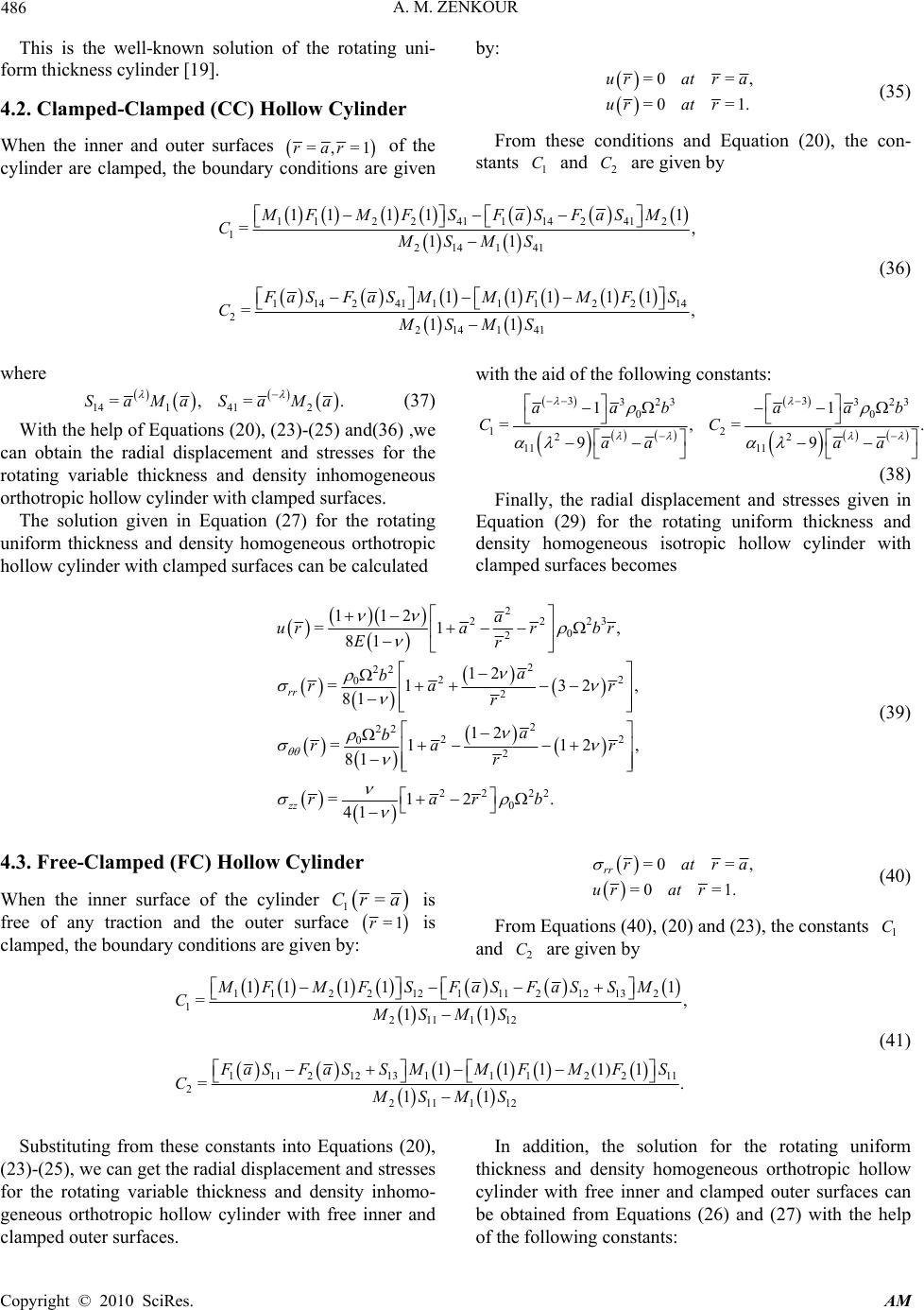 A. M. ZENKOUR Copyright © 2010 SciRes. AM 486 This is the well-known solution of the rotating uni- form thickness cylinder [19]. 4.2. Clamped-Clamped (CC) Hollow Cylinder When the inner and outer surfaces =,=1rar of the cylinder are clamped, the boundary conditions are given by: =0= , =0 =1. urat ra urat r (35) From these conditions and Equation (20), the con- stants 1 C and 2 C are given by 112241114241 2 1214141 1142 411112214 2214141 11 111 =, 11 11111 =, 11 MFMF S FaSFaSM CMSMS FaSFaS MMFMFS CMSMS (36) where 141 412 =,= .SaMaSaMa (37) With the h elp of Equation s (2 0), ( 23)-(25) and(36) ,w e can obtain the radial displacement and stresses for the rotating variable thickness and density inhomogeneous orthotropic hollow cylinder with clamped surfaces. The solution given in Equation (27) for the rotating uniform thickness and density homogeneous orthotropic hollow cylinder with clamped surfaces can be calculated with the aid of the following co nstants: 33 323 323 00 12 22 11 11 11 =,=. 99 aab aab CC aa aa (38) Finally, the radial displacement and stresses given in Equation (29) for the rotating uniform thickness and density homogeneous isotropic hollow cylinder with clamped surfaces becomes 2 2223 0 2 2 22 22 02 2 22 22 02 22 22 0 112 =1 , 81 12 =1 32, 81 12 =1 12, 81 =12 . 41 rr zz a urar br Er a b rar r a b ra r r rarb (39) 4.3. Free-Clamped (FC) Hollow Cylinder When the inner surface of the cylinder 1=Cr a is free of any traction and the outer surface =1r is clamped, the boundary conditions are given by: =0= , =0 =1. rr ratra urat r (40) From Equations (40), (20) and (23), the constants 1 C and 2 C are given by 112212111212 132 1211112 111 212 13 1112211 2211112 11 111 =, 11 111(1)1 =. 11 MFMF S FaSFaSSM CMSMS FaSFaSS MMFMFS CMSMS (41) Substituting from these constants into Equations (20), (23)-(25), we can get the radial displacement and stresses for the rotating variable thickness and density inhomo- geneous orthotropic hollow cylinder with free inner and clamped outer surfaces. In addition, the solution for the rotating uniform thickness and density homogeneous orthotropic hollow cylinder with free inner and clamped outer surfaces can be obtained from Equations (26) and (27) with the help of the following constants: 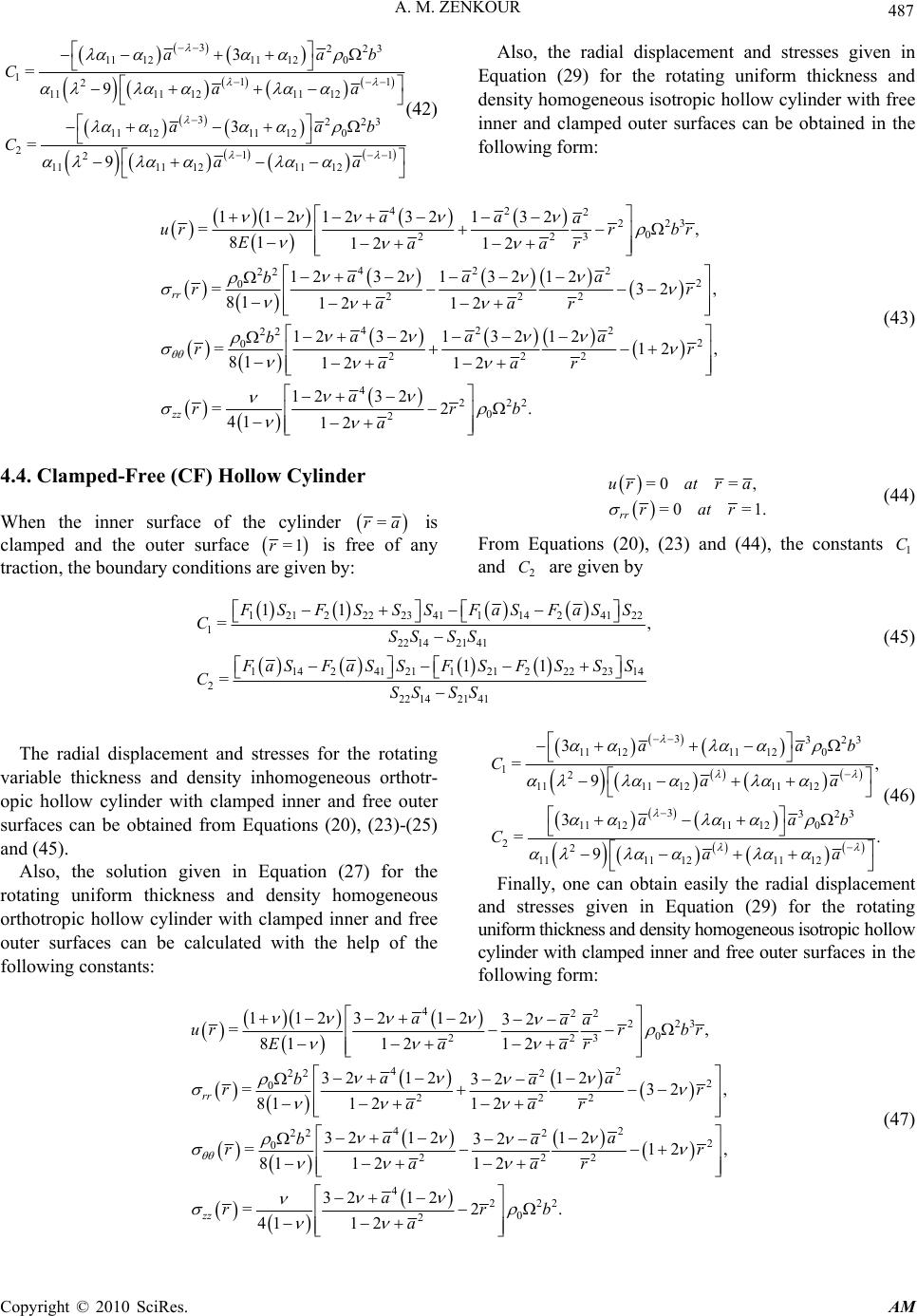 A. M. ZENKOUR Copyright © 2010 SciRes. AM 487 3223 11 1211 120 111 2 1111 1211 12 3223 11 1211 120 211 2 1111 121112 3 =9 3 =9 aab Caa aab Caa (42) Also, the radial displacement and stresses given in Equation (29) for the rotating uniform thickness and density homogeneous isotropic hollow cylinder with free inner and clamped outer surfaces can be obtained in the following form: 42 2223 0 223 42 2 22 2 0222 42 2 22 022 11212321 32 =, 81 12 12 1232132 12 =32, 81 12 12 1232132 12 =811212 rr aa a urr br Eaar aa a b rr aar aa a b raa 2 2 4222 0 2 12 , 12 32 =2. 41 12 zz r r a rrb a (43) 4.4. Clamped-Free (CF) Hollow Cylinder When the inner surface of the cylinder =ra is clamped and the outer surface =1r is free of any traction, the bound ary conditions are given by: =0= , =0 =1. rr urat ra ratr (44) From Equations (20), (23) and (44), the constants 1 C and 2 C are given by 1212222341114241 22 1221421 41 114 24121121222 2314 222 1421 41 11 =, 11 = FS FS SSFaS FaSS CSSSS FaSFaS SFSFSS S CSS SS (45) The radial displacement and stresses for the rotating variable thickness and density inhomogeneous orthotr- opic hollow cylinder with clamped inner and free outer surfaces can be obtained from Equations (20), (23)-(25) and (45). Also, the solution given in Equation (27) for the rotating uniform thickness and density homogeneous orthotropic hollow cylinder with clamped inner and free outer surfaces can be calculated with the help of the following constants: 3323 11 1211120 12 11111211 12 3323 11 1211 120 22 11111211 12 3 =, 9 3 =. 9 aab Caa aab Caa (46) Finally, one can obtain easily the radial displacement and stresses given in Equation (29) for the rotating uniform thickne ss and densit y hom ogeneous is otropic hollow cylinder with clamped inner and free outer surfaces in the following form: 422 223 0 223 42 22 22 0222 42 22 2 0222 11232 12 32 =, 81 12 12 32 1212 32 =32, 81 12 12 32 1212 32 =8112 12 rr aaa urr br Eaar aa ba rr aar aa ba raar 2 4222 0 2 12 , 32 12 =2. 41 12 zz r a rrb a (47)  A. M. ZENKOUR Copyright © 2010 SciRes. AM 488 5. Conclusions The rotation problem of a variable-thickness inhomogen- eous, orthotropic, hollow cylinder has been studied. Analytical solution for rotating variable-thickness, in- homogeneous, orthotropic, hollow cylinder subjected to different boundary conditions are derived. The displace- ment and stresses for rotating uniform-thickness, homo- geneous, isotropic, hollow cylinder are obtained as special cases of the investigated problem. In the second part of this paper we will present the corresponding viscoelastic solutions and some applications concerning the effects due to many parameters on the radial displace- ment and stresses. 6. References [1] Yu. É. Senitskii, “Stress State of a Rotating Inhomoge- neous Anisotropic Cylinder of Variable Density,” Inter- national Applied Mechanics, Vol. 28, No. 5, 1992, pp. 28-35. [2] C. O. Horgan and A. M. Chan, “The Pressurized Hollow Cylinder or Disk Problem for Functionally Graded Iso- tropic Linear Elastic Materials,” Journal of Elasticity, Vol. 55, No. 1, 1999, pp. 43-59. [3] A. T. Vasilenko and N. I. Klimenko, “Stress State of Rotating Inhomogeneous Anisotropic Cylinders,” Inter- national Applied Mechanics, Vol. 35, No. 8, 1999, pp. 778-783. [4] F. Rooney and M. Ferrari, “Tension, Bending, and Flex- ure of Functionally Graded Cylinders,” International Journal of Solids and Structures, Vol. 38, No. 3, 2001, pp. 413-421. [5] Ya. M. Grigorenko and A. T. Vasilenko, “The Effect of Inhomogeneity of Elastic Properties on the Stress State in Composite Cylindrical Panels,” Mechanics of Composite Materials, Vol. 37, No. 2, 2001, pp. 85-90. [6] A. Oral and G. Anlas, “Effects of Radially Varying Mod- uli on Stress Distribution of Nonhomogeneous Aniso- tropic Cylindrical Bodies,” International Journal of Sol- ids and Structures, Vol. 42, No. 20, 2005, pp. 5568-5588. [7] E. Pan and A. K. Roy, “A Simple Plane-strain Solution for Functionally Graded Multilayered Isotropic Cylind- ers,” Structural Engineering and Mechanics, Vol. 24, No. 6, 2006, pp. 727-740. [8] N. Tutuncu, “Stresses in Thick-walled FGM Cylinders with Exponentially-varying Properties,” Engineering Structures, Vol. 29, No. 9, 2007, pp. 2032-2035. [9] E. E. Theotokoglou and I. H. Stampouloglou, “The Ra- dially Nonhomogeneous Elastic Axisymmentric Prob- lem,” International Journal of Solids and Structures, Vol. 45, No. 25-26, 2008, pp. 6535-6552. [10] M. Mohammadi and J. R. Dryden, “Influence of the Spa- tial Variation of Poisson’s Ratio upon the Elastic Field in Nonhomogeneous Axisymmetric Bodies,” International Journal of Solids and Structures, Vol. 46, No. 3-4, 2009, pp. 788-795. [11] X. F. Li and X. L. Peng, “A Pressurized Functionally Graded Hollow Cylinder with Arbitrarily Varying Ma- terial Properties,” Journal of Elasticity, Vol. 96, No. 1, 2009, pp. 81-95. [12] Ya. M. Grigorenko and L. S. Rozhok, “Stress Analysis of Hollow Elliptic Cylinders with Variable Eccentricity and Thickness,” International Applied Mechanics, Vol. 38, No. 8, 2002, pp. 954-966. [13] A. M. Zenkour, “Rotating Variable-thickness Orthotropic Cylinder Containing a Solid Core of Uniform-thickness,” Archive of Applied Mechanics, Vol. 76, No. 1-2, 2006, pp. 89-102. [14] A. M. Zenkour, “Stresses in Cross-ply Laminated Circu- lar Cylinders of Axially Variable Thickness,” Acta Me- chanica, Vol. 187, No. 1-4, 2006, pp. 85-102. [15] W. H. Duan and C. G. Koh, “Axisymmetric Transverse Vibrations of Circular Cylindrical Shells with Variable Thickness,” Journal of Sound and Vibration, Vol. 317, No. 3-5, 2008, pp. 1035-1041. [16] G. J. Nie and R. C. Batra , “Static Deformations of Func- tionally Graded Polar-orthotropic Cylinders with Elliptic- al Inner and Circular Outer Surfaces,” Composites Science and Technology, Vol. 70, No. 3, 2010, pp. 450-457. [17] M. Abramowitz and A. I. Stegun, “Handbook of Mathe- matical Functions,” 5th Edition, US Government Printing Office, Washington DC, 1966. [18] H. J. Ding, H. M. Wang and W.Q. Chen, “A Solution of a Non-homogeneous Orthotropic Cylindrical Shell for Axisymmetric Plane Strain Dynamic Thermoelastic Problems,” Journal of Sound and Vibration, Vol. 236, No. 4, 2003, pp. 815-829. [19] L. S. Srinath, “Advanced Mechanics of Solids,” McGraw-Hill, India, 1983. |

